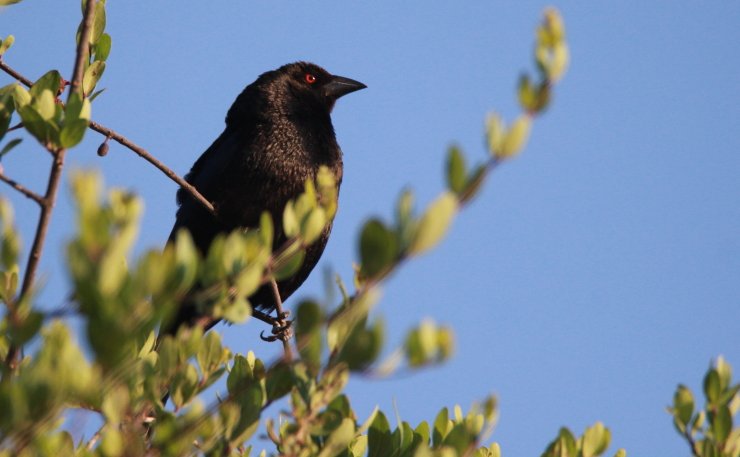
I hope you will forgive my rather lurid title. No, I am not going to tell you about some blood-sucking bird with hypnotic powers. I am only responding to my subjective impression of a single species’ appearance here; specifically, that of the Bronzed Cowbird. (For our Old World readers, yes, I am aware that Oxpeckers would be more deserving of this title.)
Male Bronzed Cowbirds have, in spite of their name, irridescent blue-black plumage. But in most light, they appear to have a shiny black color. Males also have a ruff of feathers around their necks that, when relaxed, give them a slightly hunchbacked look (Igor?). But when raised, they seem to have a sort of weird cape. (Dracula!) They have a slightly ghoulish reproductive system, about which, more below. And then there are those startling bright red eyes, which distinguish them from all other blackbirds in my region, and make them look quite capable of peering into your soul and taking over your will.
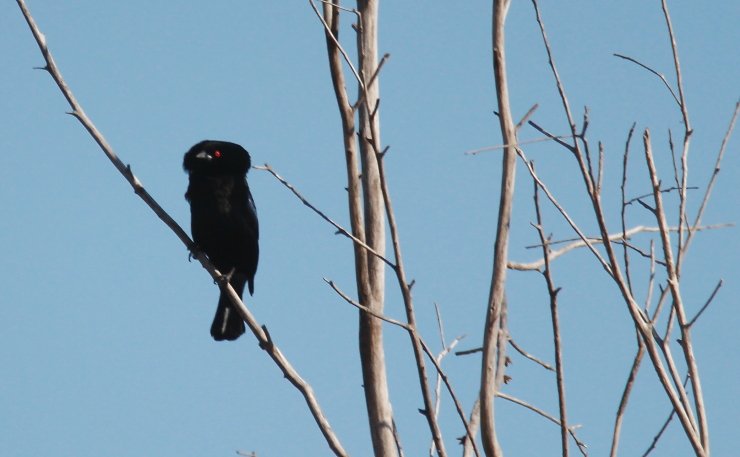 I’m not particularly proud of these photos. But the bird is cool, and I need the photos to prove my points.
I’m not particularly proud of these photos. But the bird is cool, and I need the photos to prove my points.
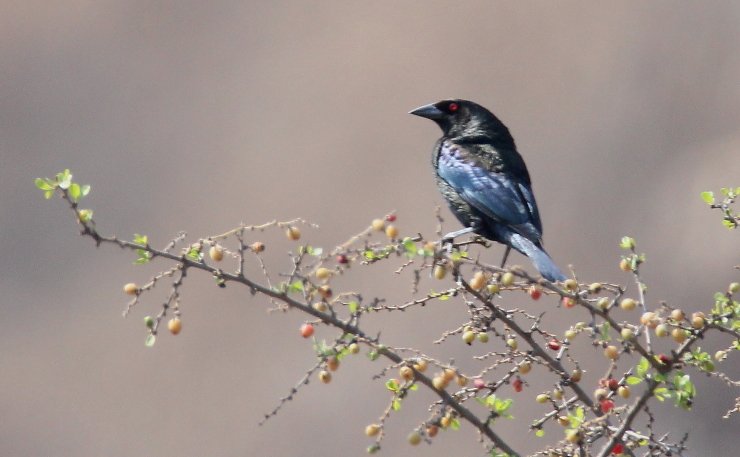
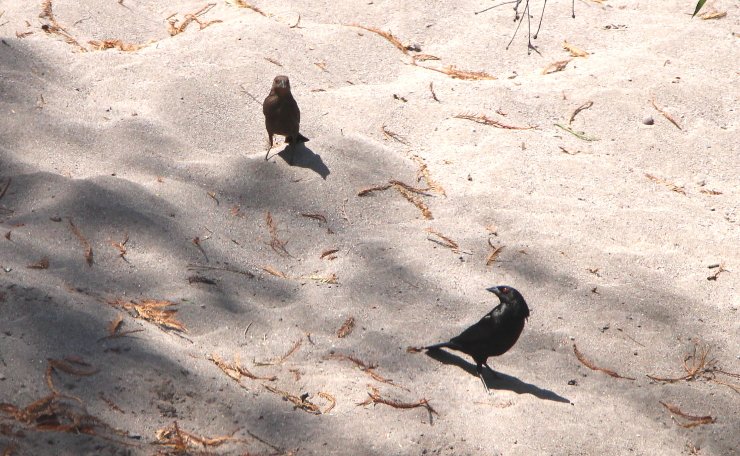 A rare photo (for me) of a glossy male and its more drab partner.
A rare photo (for me) of a glossy male and its more drab partner.
In spite of this somewhat disconcerting appearance, I am rather fond of the Bronzed Cowbird. Especially when I compare it with the other cowbird present in central Mexico, the Brown-headed Cowbird.
Both (in fact, all) cowbirds are obligate brood parasites. In other words, they never raise their own young. Instead, they lay their eggs in other species’ nests, and let those nest-making birds (often significantly smaller than the cowbirds) raise their young. So that is a negative mark on both their records. But Brown-headed Cowbirds have a particularly nasty practice: if the host parents defend their nest by removing the cowbird egg, the cowbird parents will often destroy the host nest, forcing the hosts to build a new one, which is then also parasitized. Biologists call this “mafia behavior”. So that’s another mark against them.
But there are two main reasons for my sympathy towards Bronzed Cowbirds and antipathy towards Brown-headed Cowbirds. First, the Bronzed Cowbird belongs here. Its historical year-round range stretches from extreme northwestern Colombia to northern Mexico, with migration into the southwestern United States in the summer.
In contrast, the Brown-headed Cowbird is a same-continent invasive species. Admittedly, the story of their expansion is an interesting one. This species was once restricted to North America’s Great Plains, where they followed herds of American Bison, eating both the seeds in their dung and the creatures that bison’s trampling brought into the open. Since bison herds move constantly to find fresh forage, the Brown-headed Cowbirds that followed them had a very good reason for leaving their young in the care of other birdsg.
But all this changed with the arrival of Europeans, and their cattle. The Brown-headed “Bison-birds” learned to be Cowbirds, and expanded their range coast-to-coast, and into almost all of Mexico. Also, as ranchers increasingly moved their free-range cattle into feedlots, they settled down and became incredibly numerous. Starling-numerous. Which meant their brood parasitism became both unnecessary, and a really big problem. Just ask the Wood Warblers.
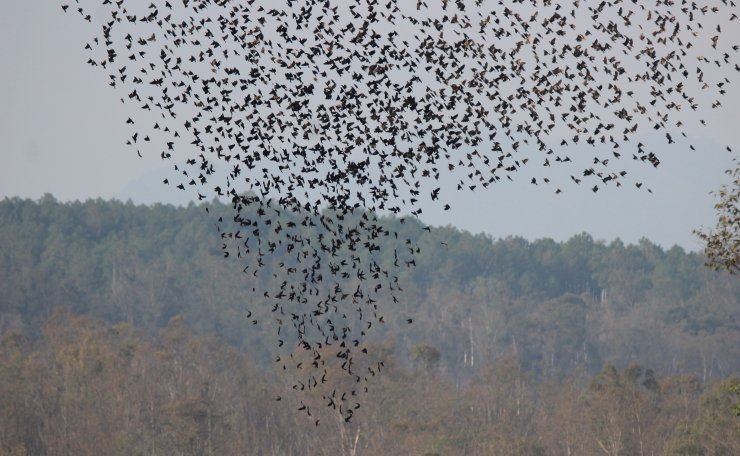 I witnessed this Brown-headed Cowbird-nado near the church we pastor.
I witnessed this Brown-headed Cowbird-nado near the church we pastor.
As the above photo shows, I often see Brown-headed Cowbirds in flocks of hundreds of individuals. In fact, this is not even a particularly large group. And that represents an enormous number of parents from other species neglecting their own young.
But a quick look at my eBird records show that I have only seen double-digit numbers of Bronzed Cowbirds a handful of times, while I see single-digit groups quite often, in a wide variety of habitats. Oddly, both species are mostly to be seen around my highland area from December through May, even though Bronzed Cowbirds are reputed to be year-round residents here, and we are supposed to be just south of the Brown-headed Cowbird’s breeding range.
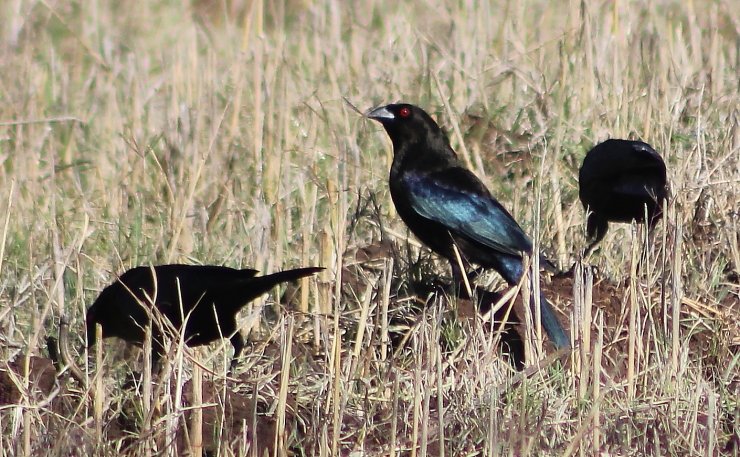 This is a rather typical group size for Bronzed Cowbirds.
This is a rather typical group size for Bronzed Cowbirds.
So there you are. A cool, slightly spooky blackbird versus a muddy-looking blackbird? I’ll choose the Bronzed Cowbird. Native versus invasive species? Ditto. Less versus way-more brood parasitism? Double-ditto. I pick the Bronzed Cowbird every time!
But maybe I just got hypnotized by those deep red eyes.
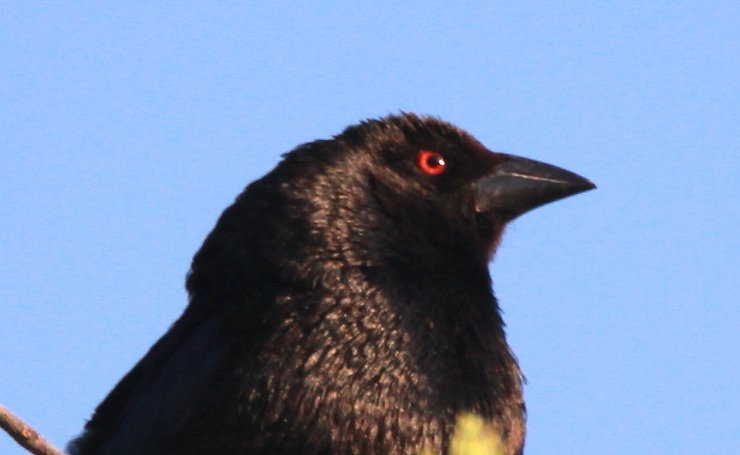











Good name for that bird! Interesting to hear that you don’t see it in large numbers and makes me wonder if there are more ecosystem factors there that affect Bronzed Cowbird populations than in Costa Rica. In Costa Rica, it does occur in large numbers outside of the breeding season and although the bird is native, I strongly suspect that the species colonized this country (or at least greatly increased) as a result of deforestation and cattle production quite some time ago. Here, it does seem to be associated with and might need cattle to survive.
Hopefully we can have more studies in Costa Rica to show what sort of impact Bronzed Cowbirds have on local bird populations.
I find it fascinating to compare notes with you, Patrick. I would not have expected what you write to be true; but then, you don’t have Brown-headed Cowbirds to fill that niche, so it makes sense that the Bronzed Cowbirds would. Here, Bronzeds are rarely seen near cattle. No doubt they are crowded out by the competition.